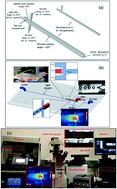Picoliter agar droplet breakup in microfluidics meets microbiology application: numerical and experimental approaches†
Abstract
Droplet microfluidics has provided lab-on-a-chip platforms with the capability of bacteria encapsulation in biomaterials, controlled culture environments, and live monitoring of growth and proliferation. The droplets are mainly generated from biomaterials with temperature dependent gelation behavior which necessitates stable and size-controlled droplet formation within microfluidics. Here, the biomaterial is agar hydrogel with a non-Newtonian response at operating temperatures below 40 °C, the upper-temperature threshold for cells and pathogens. The size of the produced droplets and the formation regimes are examined when the agar is injected at a constant temperature of 37 °C with agar concentrations of 0.5%, 1%, and 2% and different flow rate ratios of the dispersed phase to the continuous phase (φ: 0.1 to 1). The numerical simulations show that φ and the capillary number (Ca) are the key parameters controlling the agar droplet size and formation regime, from dripping to jetting. Also, increasing the agar concentration produces smaller droplets. The simulation data were validated against experimental agar droplet generation and transport in microfluidics. This work helps to understand the physics of droplet generation in droplet microfluidic systems operating with non-Newtonian fluids. Pathogenic bacteria were successfully cultured and monitored in high resolution in agar droplets for further research in antibiotic susceptibility testing in bacteremia and urinary tract infection.



 Please wait while we load your content...
Please wait while we load your content...